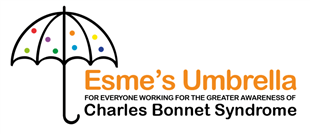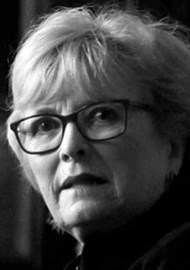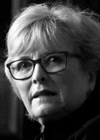The founder of Esme’s Umbrella shares her experience with the poorly understood condition Charles Bonnet Syndrome and the creation of the campaign.
Many years ago, when I was a young actress, I was in an American play called ‘Butterflies are Free’. I played the girlfriend of Don, a young, blind musician. Our director was from the ‘method’ school of acting and insisted that for the first three days of rehearsals we were all blindfolded. He wanted us to gain some understanding of the dark world of the blind. That experience made a great impact on me and I have never forgotten the feelings of panic, helplessness and isolation – and this was only for three days.
Little did I know then that, 30 years later, my Mother – Esme – would develop glaucoma and gradually lose her sight. She was a proud, independent lady and a marvellous improviser. At first, she found ways of coping by adapting and adjusting in the most remarkable way, still managing to complete The Telegraph cryptic crossword every day, but not knowing how long she had left in a sighted world was very hard for her to bear.

Esme.
What neither of us expected was that something else was lurking – something which would destroy her independence, her confidence and blight her final years. One day, as I was about to leave her flat, she suddenly said “I do wish these people would get off my sofa.” There was no one on her sofa but when I told her this, she said “They do go if I tap them on their shoulders.” I questioned her more closely and was horrified to hear, not only about the faceless people on her sofa, but about a gargoyle-like creature which jumped from table to chair, a tear-stained Edwardian street-child who followed her everywhere and how the whole room could morph into an alien place.
I had absolutely no idea what could be causing these ‘visions’ as she called them. The word ‘dementia’ hovered in the air between us, but I could not believe there was anything wrong with her mind. After all, her ability with the crossword was considerably greater than mine.
Somewhat reluctantly, I left her and drove home, pondering what to do. With a huge piece of luck, that very day, I found a tiny article in one of the newspapers about something called Charles Bonnet Syndrome (CBS). It described perfectly what Esme was experiencing and, greatly relieved, I rang to reassure her that the hallucinations were being caused by her loss of sight and that the condition had a name. Now, all I had to do was call her ophthalmologist for help.
To my astonishment, Esme’s ophthalmologist refused to discuss CBS and, when I asked why he had not warned us this might happen, he told me it was his clinical judgment not to warn his patients and – as we discovered at Esme’s next appointment – he would not allow any member of his team to discuss it either. Neither Esme’s GP nor optometrist had heard of CBS but the latter showed enormous interest when I was able to explain it to him.
Eventually, I found Dr Dominic ffytche at King’s College London. Dominic is the sole researcher of CBS and globally-acknowledged expert. He confirmed that Esme had developed CBS, that it was not a mental health condition but that there were no CBS consultants and precious little suitable medication to alleviate the hallucinations.

Dominic ffytche.
He explained that when more than 60% of sight is lost – from any of the eye diseases, stroke, cancer, diabetes or another condition which damages the optic nerve – the messages from the retina to the visual cortex slow or stop, but the brain does not. It fires up and creates its own images. These are entirely visual, with none of the other four senses being involved and what is seen depends on which part of the brain is firing.
I took all this information to Esme, for whom the hallucinations were taking over her life and causing anxiety, distress and depression. Between us, we tried some coping strategies to switch off the cells and halt the hallucination – sweeping the gargoyle off the table, reaching out to the child or, as Esme had unwittingly found worked, tapping the faceless people on their shoulders.
The campaign
At the time, I was writing a health column for The Telegraph and CBS became one of my subjects. Reading so many emails and comments from people who were trying to cope with something they thought was exclusive to them and a mental health issue, I realised an awareness campaign was needed.
This came to fruition after Esme died. I dithered for a while but, one day, I received an email from a professor at a university in New York, who told me that, on the advice of a doctor, her mother had been admitted to a dementia unit – despite seeming entirely sane to the family – where she died. Not being able to tolerate the perceived writhing worms, slugs and dirt on her food and in her drink, her mother stopped eating and drinking, with tragic results. No member of staff in the unit had heard of CBS and, consequently, there was no reassurance given – the lady simply being described as ‘demented’. The professor told me she would never forgive herself.
That was the final straw and, with the support of The Help and Information Service, I launched Esme’s Umbrella at the House of Commons in November 2015 with Dr Dominic ffytche as my medical adviser. Through his work, Dominic has debunked three myths that had grown up around the condition. First of all, he has proved that CBS can affect anyone of any age – indeed the youngest person he has seen with the condition was a two-year-old child. Secondly, that CBS can last for the whole of the person’s life – as it did with Esme – and, thirdly, that the hallucinations are not necessarily benign.
We have no data on the prevalence of CBS. This is partly because many people living with the condition are too frightened that the hallucinations are due to a mental health issue or too embarrassed about what they are seeing, to confide in anyone; partly because it was considered a condition only of the elderly; and partly because the negative effects of the condition have not been appreciated. However, Dominic estimates that there are a million people living with CBS in the UK.
My first aim has been to ensure that ophthalmologists explain about CBS and warn their patients that it might develop. It might not, but forewarned is forearmed and should a medieval army march through the garden or the room morph into a fast-flowing river or be invaded by a weary-looking second world war pilot, a snarling tiger, a Lilliputian-sized family – or should a tarantula crawl from the pages of a book and frogs flow from the tap, it makes it marginally easier to cope if CBS has been mentioned by the ophthalmologist.
I was invited to speak at the Royal College of Ophthalmology’s Congress in Liverpool last May and I hope that those ophthalmologists who heard me went away with a greater understanding of CBS and will now warn their patients.

Judith Potts speaking at the Royal College of Ophthalmologists’ Congress in Liverpool May 2018.
Benign images like beautiful flowers or cavorting kittens make CBS easier to tolerate – even though the frequency can be debilitating. However, people with multiple hallucinations can become housebound, because it becomes impossible to distinguish what is real and what is not. Others find the hallucinations so terrifying, particularly if the images are sexually inappropriate, that the prospect of suicide raises its head.
Young professionals with CBS find their hallucinations constantly disrupt their concentration at meetings and make the already-difficult-enough journeys on public transport into a real nightmare. At any age, falls can happen, whilst trying to avoid the sudden appearance of a wall, a giant truck or a tiger. Misdiagnosis, through lack of awareness of CBS, can follow and, as happens all too often, people in an older age group find themselves ushered down the mental health route – sometimes on a one-way ticket.
Hallucinations of fire, people in the house, or water, often drive calls to the fire brigade and the police – who have probably never heard of CBS and, understandably, question the waste of time.
I know all this from speaking to hundreds and hundreds of people who have contacted me over the last three years. Last year, with General Data Protection Regulation (GDPR) considerations and an escalation in calls, I had to relinquish my Helpline to the Eye Health Team at the Royal National Institute of Blind People (RNIB) and Retina UK’s Helpline. The number to ring is 020 7391 3299 and if the caller would like to speak to someone who lives with CBS, they can be referred to Retina UK.
Apart from the obvious need to find treatment and a cure for CBS, support for those who are living with this distressing condition is vital. I have launched a series of Esme Room Support Groups in local low vision charities, with more to come. Being able to meet and exchange experiences with others who understand exactly what it is like to live with CBS is very reassuring. I want now to find Esme’s ‘Buddies’ who will talk face-to-face or on the telephone and Esme’s Counsellors who will offer a couple of free sessions – either one-to-one or in a group, to include family and friends too. It is very important that CBS is understood by relatives and carers, who might also need support.
Building momentum
Last November – to coincide with CBS Awareness Day – I hosted the world’s first CBS Patient Day. Moorfields gave us the venue and the event was attended by ophthalmologists, researchers, doctors, patients, statisticians, medical students, eye clinic liaison officers, rehabilitation officers for the visually impaired and representatives from the large eye charities, who supported the event. We heard from Dr Dominic ffytche, Dr John Paul Taylor and Kat da Silva Morgan. Kat is working with Dr Greg Elder at Newcastle University, in the name of Esme’s Umbrella – funded by Fight for Sight, The Thomas Pocklington Trust and the National Eye Research Centre – comparing the brains of people with sight loss and CBS against those with sight loss who do not develop the condition. If we can identify the difference, we will be on the way to finding a non-medication, non-invasive treatment to switch off the hallucinations. This is being researched by Dr Taylor at the same university, funded by The Macular Society.
More of my aims are to establish CBS specialist nurses, to whom ophthalmologists can refer patients; to include a tick-box on the Certificate of Vision Impairment (CVI) form, which confirms that the ophthalmologist has explained CBS to the patient; and to continue raising awareness and funds for research, targeting care homes and healthcare givers of all types.
CBS should be recognised as a condition in its own right and Dr August Colenbrander at Smith Kettlewell in the USA – who is spearheading the ophthalmology section of the World Health Organisation’s new taxonomy of diseases and conditions, ICD11 – hopes that when the proposals of the International Council are followed, it is highly likely that there will be a code for CBS. Inclusion in ICD-11 could be a massive step forward and would encourage funding for this vital research – or for the NHS to step forward and lead the world.
Misdiagnosis of CBS with its wasted medication is costing millions. The NHS needs to create a proper pathway for diagnosis, treatment and social care. The number of people affected by sight loss in the UK is set to double to four million by 2050, carrying CBS with them.
I watched powerlessly as loss of sight and the torment of CBS took its toll on Esme. There was no one to help then, but now her name is synonymous with CBS and the next step is to find ambassadors who will help to raise yet more awareness. In 2019, no one should have their life dramatically and negatively altered by what Charles Bonnet himself described – over 250 years ago – as ‘the theatre of the mind’.
BLIND ARTIST
Amateur artist Arthur Ellis lost his sight to bacterial meningitis in 2006. His artwork now includes representations of his CBS hallucinations.

You can read his story and see his paintings at www.blindartist.co.uk
COMMENTS ARE WELCOME








